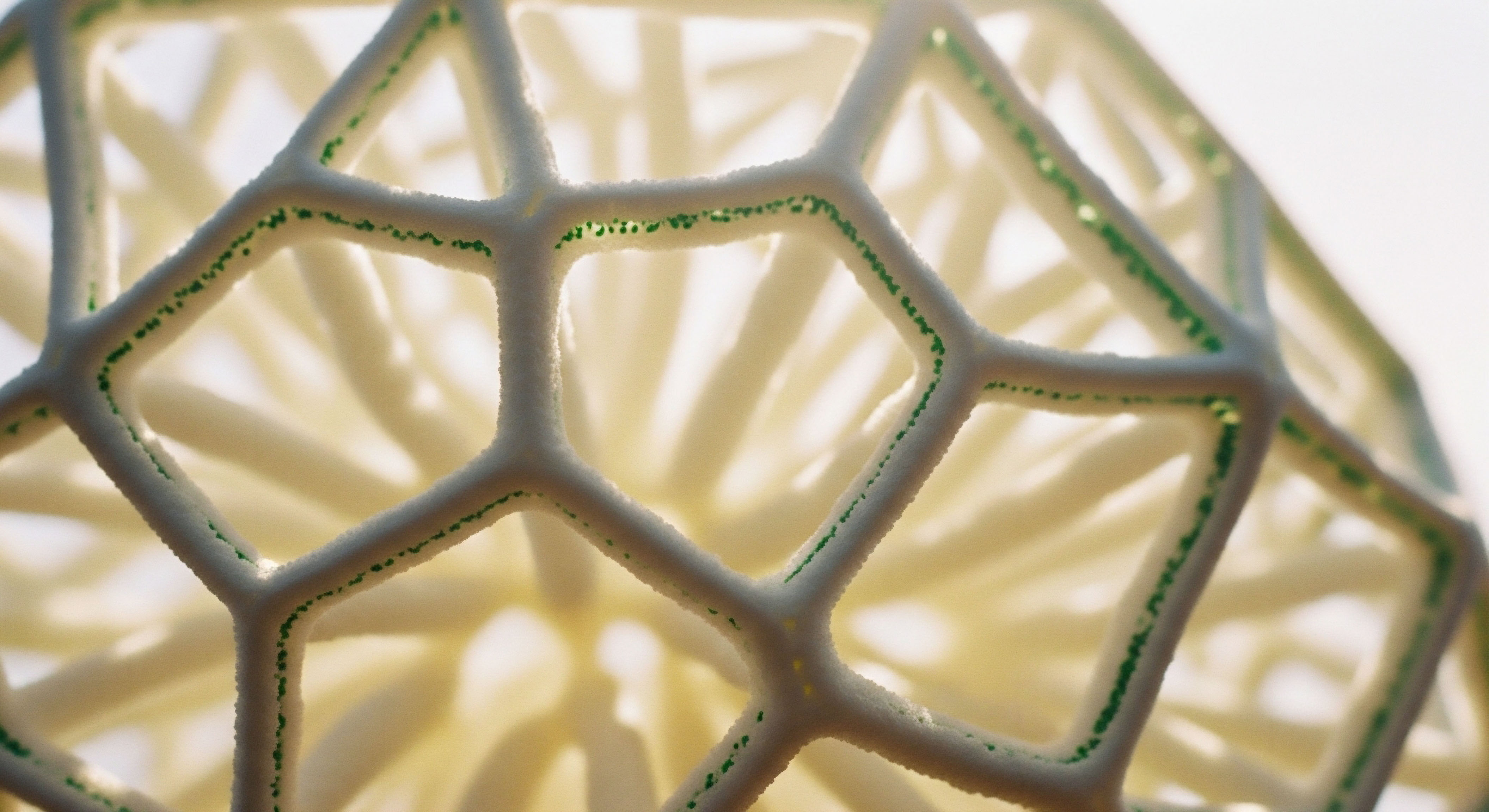

Fundamentals
You may have noticed a shift in the way your body recovers. The resilience that once felt innate, the capacity to bounce back from a strenuous workout or a demanding day, seems to have diminished. This experience of slowed repair and lingering fatigue is a deeply personal one, yet it is rooted in the universal biological language of cellular communication.
Your body is a vast, interconnected network of systems, and the efficiency of its maintenance crews ∞ the mechanisms of cellular repair ∞ is governed by a precise set of molecular instructions. Understanding this internal signaling architecture is the first step toward reclaiming your body’s inherent vitality.
At the heart of this communication network are peptides and hormones, the body’s primary chemical messengers. These molecules are responsible for orchestrating complex processes, from metabolism to growth. Growth hormone (GH), a protein produced by the pituitary gland, is a principal conductor of this orchestra.
It directs the body’s resources toward growth during youth and, crucially, toward maintenance and repair throughout adult life. Its influence is profound, touching nearly every cell and tissue. When the signal from GH becomes less frequent or less powerful, the entire system of regeneration can slow down. The feeling of being unable to fully recover is a direct reflection of this change at the microscopic level.

The Architecture of Hormonal Communication
The body’s endocrine system operates through a series of sophisticated feedback loops, much like a thermostat regulating room temperature. The process begins in the brain, within the hypothalamus, which acts as the command center. It releases growth hormone-releasing hormone (GHRH), a specific peptide that travels a short distance to the pituitary gland.
This signal instructs the pituitary to secrete its stored growth hormone into the bloodstream. Once in circulation, GH travels to the liver and other tissues, where it stimulates the production of another critical factor ∞ insulin-like growth factor 1 (IGF-1). It is largely through IGF-1 that the profound anabolic and restorative effects of GH are realized.
IGF-1 is the field operative, carrying out the instructions for cellular repair, protein synthesis, and tissue regeneration. This entire sequence, from the hypothalamus to the pituitary to the liver, is known as the GH axis.

What Governs the Rhythm of Repair?
The release of growth hormone is not a constant stream; it is pulsatile, occurring in bursts, primarily during deep sleep and after intense physical exertion. This natural rhythm is essential for its proper function and prevents the body from becoming desensitized to its effects.
The health of this pulse determines the strength of the signal for cellular repair. As we age, the amplitude and frequency of these GH pulses naturally decline. This biological shift contributes directly to many of the observable signs of aging, such as decreased muscle mass, reduced skin elasticity, and the prolonged recovery times that you may be experiencing. The communication becomes quieter, and the body’s repair crews are deployed with less vigor.
The sensation of diminished recovery is a direct physiological echo of a reduction in the body’s natural growth hormone signals.
Growth hormone peptides are designed to interact with this system in a precise way. They are synthetic molecules that mimic the body’s own signaling compounds. Some, like Sermorelin, are analogs of GHRH, providing a clear signal to the pituitary to release its stored GH.
Others, like Ipamorelin, work through a different but complementary mechanism, acting on a separate receptor to stimulate GH release while also helping to regulate the body’s internal checks and balances. The purpose of these peptides is to restore the natural, youthful rhythm of GH secretion, thereby amplifying the body’s own capacity for cellular repair.
By revitalizing the pulsatile nature of GH release, these therapies help to re-establish a more robust signaling environment. This enhanced communication awakens the downstream processes of tissue regeneration. The result is a systemic improvement in the body’s ability to maintain and repair itself, addressing the root cause of the fatigue and slow recovery that can impact an adult’s quality of life.
- Delayed Muscle Soreness ∞ A workout that once required a day of recovery might now lead to soreness lasting for several days, indicating slower muscle fiber repair.
- Joint Aches and Stiffness ∞ Persistent discomfort in joints can point to a reduced capacity for cartilage and connective tissue maintenance.
- Changes in Skin and Hair ∞ Thinner skin, fine lines, and brittle hair can be external signs of decreased collagen synthesis, a process heavily influenced by GH and IGF-1.
- Difficulty Losing Body Fat ∞ A sluggish metabolism, particularly an inability to effectively mobilize stored fat for energy, is linked to lower GH levels.
- Poor Sleep Quality ∞ Waking up feeling unrested is common, as the primary pulse of GH release occurs during the deep stages of sleep. A disruption in one often accompanies a disruption in the other.


Intermediate
Moving beyond foundational concepts, a deeper clinical perspective reveals how specific peptide protocols are structured to revitalize the body’s cellular repair machinery. The therapeutic goal is a precise recalibration of the growth hormone axis. This is accomplished by using specific growth hormone secretagogues (GHS), which are peptides that prompt the pituitary gland to secrete endogenous GH.
This method honors the body’s innate biological pathways, working with its natural pulsatile rhythm instead of overriding it with exogenous hormones. Two main classes of GHS are used, often in combination, to achieve a synergistic effect ∞ Growth Hormone-Releasing Hormone (GHRH) analogs and Growth Hormone-Releasing Peptides (GHRPs).

Differentiating the Primary Signaling Peptides
GHRH analogs, such as Sermorelin and CJC-1295, function as mimetics of the body’s own GHRH. They bind to the GHRH receptor on the pituitary gland, directly stimulating the synthesis and release of growth hormone. Their action is straightforward and follows the primary natural pathway for GH secretion.
The duration of their signal can vary, with Sermorelin having a short half-life that produces a quick, clean pulse, while CJC-1295 (particularly the version with Drug Affinity Complex, or DAC) is modified for a much longer half-life, creating a sustained elevation in baseline GH levels.
GHRPs, which include Ipamorelin and Hexarelin, operate through a different mechanism. They bind to the GHS-R1a receptor, the same receptor activated by ghrelin, a hormone associated with hunger and energy balance. Activating this receptor also triggers a powerful release of GH from the pituitary.
Ipamorelin is highly valued for its selectivity; it stimulates a strong GH pulse without significantly affecting other hormones like cortisol or prolactin. This dual-receptor strategy, combining a GHRH analog with a GHRP, is the cornerstone of modern peptide therapy. The GHRH analog “opens the door” for GH release, while the GHRP provides a secondary, potent “push,” leading to a more robust and effective pulse than either could achieve alone.

How Does Peptide Synergy Amplify Cellular Repair?
The combination of a GHRH analog with a GHRP produces a synergistic effect that is greater than the sum of its parts. Research has shown that when administered together, these peptides can amplify the release of growth hormone significantly. This is because they address two distinct control points in the GH axis.
The GHRH analog increases the amount of GH the pituitary is prepared to release, while the GHRP simultaneously reduces the inhibitory signal of somatostatin, a hormone that acts as a brake on GH secretion. By “releasing the brake” and “pressing the accelerator” at the same time, the combination elicits a powerful, naturalistic pulse of GH.
This amplified pulse leads to a more significant downstream release of IGF-1 from the liver, which is the primary mediator of the anabolic and restorative effects that drive cellular repair.
Combining a GHRH analog with a GHRP creates a synergistic effect, amplifying the natural pulse of growth hormone to enhance systemic repair.
This increased IGF-1 activity translates directly into tangible benefits for tissue regeneration. It promotes the uptake of amino acids by cells, providing the raw materials for protein synthesis. This is essential for repairing muscle fibers damaged during exercise, rebuilding collagen in skin and connective tissues, and supporting the maintenance of bone density.
The enhanced signaling environment created by a strategic peptide protocol effectively turns back on the cellular machinery that may have become dormant, leading to improved recovery, increased lean muscle mass, and a reduction in body fat over time.

Comparing Key Growth Hormone Secretagogues
Selecting the appropriate peptide or combination depends on the individual’s specific goals, health status, and clinical assessment. Each compound has a unique pharmacokinetic profile that makes it suitable for different applications.
| Peptide | Mechanism of Action | Primary Benefits | Half-Life |
|---|---|---|---|
| Sermorelin | GHRH Analog | Restores natural GH pulse, improves sleep, gentle onset. | ~10-20 minutes |
| CJC-1295 (No DAC) | GHRH Analog | Stronger GH pulse than Sermorelin, muscle gain, fat loss. | ~30 minutes |
| CJC-1295 with DAC | Long-Acting GHRH Analog | Sustained elevation of GH/IGF-1, systemic repair, convenience. | ~8 days |
| Ipamorelin | Selective GHRP (Ghrelin Mimetic) | Strong, clean GH pulse, no impact on cortisol, tissue repair. | ~2 hours |
| Hexarelin | Potent GHRP (Ghrelin Mimetic) | Most potent GH release, cardiovascular benefits, but can raise cortisol/prolactin. | ~55 minutes |
The most common and clinically effective protocol for general wellness and cellular repair involves the combination of CJC-1295 (without DAC) and Ipamorelin. This blend is typically administered via subcutaneous injection once daily, before bedtime. The timing is strategic; it aligns with the body’s largest natural GH pulse, which occurs during deep sleep.
By augmenting this nocturnal pulse, the protocol maximizes the restorative processes that happen overnight, including muscle repair, memory consolidation, and immune system regulation. This approach provides a powerful stimulus for repair without creating a constant, supraphysiological level of GH, thereby preserving the sensitivity of the pituitary receptors and maintaining the integrity of the natural feedback loop.


Academic
An academic exploration of how growth hormone peptides influence cellular repair requires a focused analysis of the intracellular signaling cascades initiated by growth hormone receptor (GHR) activation. The macroscopic benefits of these peptides, such as muscle hypertrophy and improved tissue integrity, are the direct result of a highly orchestrated series of molecular events.
The primary and most critical pathway responsible for translating the GH signal into a cellular response is the Janus kinase/signal transducer and activator of transcription (JAK/STAT) pathway. Understanding this cascade at a molecular level reveals the precise mechanisms by which GH and its secretagogues direct the genetic machinery of the cell toward an anabolic and pro-survival state.

The Molecular Activation of the Growth Hormone Receptor
The process begins when a molecule of growth hormone binds to two GHRs on the cell surface, causing them to dimerize. This conformational change brings the intracellular domains of the receptors, along with their associated JAK2 proteins, into close proximity.
This proximity allows the JAK2 molecules to trans-phosphorylate each other on specific tyrosine residues, effectively switching them into an active state. Activated JAK2 then proceeds to phosphorylate multiple tyrosine residues on the intracellular tail of the GHR itself. These newly phosphorylated sites become high-affinity docking stations for a family of latent cytoplasmic transcription factors known as STATs.

What Is the Role of STAT5 in Mediating Repair?
While GH can activate several STAT proteins, it is the activation of STAT5 (specifically the isoforms STAT5a and STAT5b) that is most essential for mediating the majority of GH’s physiological effects, including cellular proliferation and survival. Once a STAT5 dimer docks onto a phosphorylated GHR, JAK2 phosphorylates a critical tyrosine residue on the STAT5 protein.
This phosphorylation event causes the STAT5 dimer to dissociate from the receptor, change its conformation, and expose a nuclear localization signal. The activated STAT5 homodimer then translocates from the cytoplasm into the nucleus. Inside the nucleus, it binds to specific DNA sequences known as gamma-interferon activated sites (GAS) in the promoter regions of GH-target genes. This binding initiates the transcription of hundreds of genes that are fundamental to cellular repair and growth.
The translocation of activated STAT5 to the nucleus is the pivotal event that translates the external growth hormone signal into a genetic program for cellular repair.
The most prominent of these target genes is IGF-1. The transcription of the IGF-1 gene, particularly in the liver, is heavily dependent on STAT5 activation. This demonstrates a direct mechanistic link between the GH pulse initiated by a peptide secretagogue and the systemic rise in IGF-1 that drives tissue repair.
Beyond IGF-1, STAT5 also upregulates the expression of genes involved in anti-apoptosis (cell survival), such as Bcl-xL, and genes controlling the cell cycle, such as Cyclin D1. This coordinated genetic program ensures that cells not only have the materials to rebuild but are also protected from premature death and are primed for proliferation when necessary, such as in the case of tissue injury.

Regulation and Specificity of the JAK STAT Pathway
The JAK/STAT pathway is subject to tight negative regulation to prevent uncontrolled signaling, which could lead to pathological conditions. A key family of proteins involved in this regulation is the Suppressors of Cytokine Signaling (SOCS). GH itself, via STAT5, induces the transcription of SOCS genes, creating a classic negative feedback loop.
SOCS proteins can then bind to activated JAK2, inhibiting its kinase activity, or compete with STAT5 for docking sites on the GHR, effectively dampening the signal. This intricate control mechanism ensures that the response to a GH pulse is transient and proportional, maintaining cellular homeostasis.
The influence of growth hormone peptides is therefore a direct consequence of their ability to initiate this entire cascade. By increasing the frequency or amplitude of GH pulses, peptides like Sermorelin and Ipamorelin provide more opportunities for GHR dimerization, JAK2 activation, and STAT5-mediated gene transcription.
This repeated stimulation of the JAK/STAT pathway is what underpins the long-term adaptations seen with peptide therapy, including enhanced lean body mass, improved collagen synthesis, and a more robust capacity for cellular repair following stress or injury.
| Molecule | Class | Function in the Pathway | Primary Result of Activation |
|---|---|---|---|
| GHR | Transmembrane Receptor | Binds extracellular GH, initiating intracellular signal. | Dimerization and JAK2 activation. |
| JAK2 | Tyrosine Kinase | Phosphorylates GHR and STAT proteins. | Activation of downstream signaling molecules. |
| STAT5 | Transcription Factor | Translocates to the nucleus to regulate gene expression. | Transcription of IGF-1, Bcl-xL, and other repair genes. |
| IGF-1 | Hormone/Growth Factor | Mediates most of GH’s anabolic and mitogenic effects. | Systemic tissue growth and repair. |
| SOCS | Regulatory Protein | Inhibits JAK2 activity to terminate the signal. | Negative feedback and signal attenuation. |
Other signaling pathways, such as the MAPK/ERK pathway and the PI3K/Akt pathway, are also activated by the GHR and contribute to the overall cellular response. The MAPK/ERK pathway is heavily involved in cell proliferation and differentiation, while the PI3K/Akt pathway is a potent promoter of cell survival and protein synthesis.
These pathways are interconnected with the JAK/STAT cascade, creating a robust signaling network that ensures the cell responds to the growth hormone signal in a comprehensive and coordinated manner. The result is a powerful shift in cellular priority toward anabolism, survival, and regeneration.
- Gene Transcription Initiation ∞ Activated STAT5 dimers bind to specific GAS elements in the DNA, recruiting co-activator proteins and RNA polymerase II to the promoter regions of target genes.
- Upregulation of IGF-1 ∞ The most critical gene transcribed is IGF-1, leading to increased synthesis and secretion of this growth factor, which then acts in an autocrine, paracrine, and endocrine fashion to stimulate repair.
- Promotion of Cell Survival ∞ STAT5 drives the expression of anti-apoptotic genes like Bcl-xL, which prevents programmed cell death in tissues undergoing stress or repair.
- Cell Cycle Progression ∞ Expression of cyclins, such as Cyclin D1, is increased, which pushes cells from a quiescent state into the growth and division cycle, essential for replacing damaged cells.
- Protein Synthesis ∞ The cumulative effect of these transcribed genes is a marked increase in the machinery and resources dedicated to synthesizing new proteins, the fundamental building blocks of all tissue.

References
- Berlanga-Acosta, Jorge, et al. “Synthetic Growth Hormone-Releasing Peptides (GHRPs) ∞ A Historical Appraisal of the Evidences Supporting Their Cytoprotective Effects.” Clinical Medicine Insights ∞ Cardiology, vol. 11, 2017, pp. 1179546817694558.
- Sigalos, John T. and Alexander W. Pastuszak. “The Safety and Efficacy of Growth Hormone Secretagogues.” Sexual Medicine Reviews, vol. 6, no. 1, 2018, pp. 45-53.
- Brooks, A. J. and M. J. Waters. “The Growth Hormone Receptor ∞ Mechanism of Receptor Activation, Cell Signaling, and Physiological Aspects.” The Journal of Endocrinology, vol. 204, no. 1, 2010, pp. 1-17.
- Carter-Su, C. J. Schwartz, and L. S. Argetsinger. “Growth Hormone Signaling Pathways.” Growth Hormone & IGF Research, vol. 28, 2016, pp. 11-15.
- Timmermans, Drew. “Growth Hormone Secretagogue Peptides | DailyDocTalk 82.” YouTube, 27 Jan. 2020.
- Teichman, S. L. et al. “Prolonged Stimulation of Growth Hormone (GH) and Insulin-Like Growth Factor I Secretion by CJC-1295, a Long-Acting Analog of GH-Releasing Hormone, in Healthy Adults.” The Journal of Clinical Endocrinology & Metabolism, vol. 91, no. 3, 2006, pp. 799-805.
- Ionescu, M. and L. A. Frohman. “Pulsatile Secretion of Growth Hormone (GH) Persists during Continuous Stimulation by CJC-1295, a Long-Acting GH-Releasing Hormone Analog.” The Journal of Clinical Endocrinology & Metabolism, vol. 91, no. 12, 2006, pp. 4792-4797.

Reflection

Calibrating Your Biological Blueprint
The information presented here provides a map of the complex biological territory governing your body’s capacity for repair. It details the messengers, the signals, and the molecular machinery that dictate how you recover and regenerate. This knowledge serves as a powerful tool, shifting the conversation from one of passive acceptance of symptoms to one of active, informed participation in your own wellness.
Your lived experience of fatigue or slowed recovery is not an abstract complaint; it is a valid data point reflecting a real change in your internal biochemistry.
Understanding these systems is the foundational step. The path forward involves seeing how this intricate web of signals applies directly to you. Your unique physiology, lifestyle, and health history create a context that will determine the most appropriate and effective strategy.
The journey to reclaim your vitality is a personal one, and it begins with the decision to translate this scientific understanding into a personalized protocol, guided by clinical expertise. You possess the capacity to recalibrate your body’s systems, and this knowledge is the key to unlocking that potential.

Glossary

cellular repair

pituitary gland

growth hormone

growth hormone-releasing

endocrine system

growth factor

igf-1

tissue regeneration

protein synthesis

growth hormone peptides

sermorelin

ipamorelin

growth hormone secretagogues

cjc-1295

ghrh analog with

peptide therapy

ghrh analog




